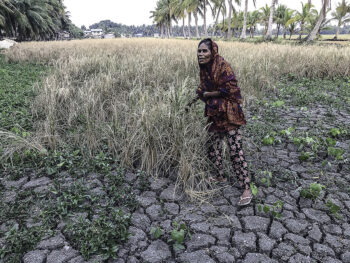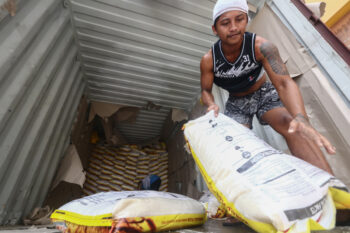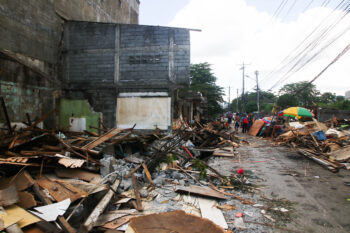Written and Directed by: Sheron Dayoc
Cinematographers: Sheron Dayoc, Arbi Barbarona, Joseph Suarez, Ryan Marcal & Mark Limbaga
Musical Score: Kit Mendoza
Sound Recorder: Maki Serapio
Sound Design: Jess Carlos
Editors: Bianca Topacio, Jolina Matthew Baquino, Maiu Mauricio
Colorist: Louie Nakpil
Executive Producer: Anak Mindanao
Line Producer: Norhaiya Casilen Diabo-Macusang
DAVAO CITY (MindaNews / 15 Dec) – If a piece of art mirrors an aspect of life and challenges its viewer to reconsider life’s meaning in a manner not perceived earlier in the mind and the heart, then Sheron Dayoc’s The Crescent Rising is not just a film, but truly a work of art!
I had looked forward to viewing this film since its first positive reviews came out after it was released on October 25, 2015 and made waves at the 2015 Quezon City International Film Festival winning the Best Documentary award, a feat which was duplicated at the 2016 Gawad Urian. More favorable reviews and awards came with the film’s presentation at the recent 21st Busan International Film Festival in Korea and winning the BIFF Mecenat Award for Best Asian Documentary.
The opportunity to catch a showing of this film arose with the 12th Mindanao Film Festival held recently at Cinema 6 of the Gaisano Mall in Davao City. I must confess I had a very high expectation of the film. Not only did the film match my expectation, but I was totally enthralled by the power of this film, not only for its artistic excellence but its bravura at attempting to capture what lies at the heart of the Mindanao tragic history and to do so without falling into the trap of a boring didactism.
And yet its formula for success is very simple: all it does is to tell stories. Stories of a few Moro peoples caught in the crossfire of wars that have bedeviled Mindanawons for generations. Told from their standpoint and punto de vista. Told from the margins of our society crying out for justice. Captured by camera lenses that embrace their deep emotions as they struggle through the vicissitudes of lives punctuated with tragic events which are already part of their everyday existence.
If one googles the film’s synopsis one finds these entries:
“Three Muslim women’s lives are the focus of this intense documentary. They have been living for the longest time in refugee camps, lost their husbands, but undeterred to fight for their wellbeing and peace in their community.”
“Three portraits of different lives caught in between a crossfire of unwavering faith and ambiguous history. In Book 1: A Man claims Jabidah Massacre is a lie; in Book 2: Moro rebel fighters believe Jihad should be a way of life and in Book 3: Women are caught in the wrath of war.”
“The film focuses on four people, each in a different situation: a middle-aged man who, as a soldier of the Moro National Liberation Front (MNLF), has devoted his whole life to teaching Islam; a young man who had joined the MNLF as a boy and became a Jihad warrior; a woman who lost her husband to the war and seven children to disease, and now lives as a refugee; and a teenaged girl who fights for the innocence of her sister, accused of being a sniper for the MNLF and is in prison.”
Indeed, the film is constituted by “interwoven stories to create a tapestry of Mindanao’s forgotten people.” But it is much more than this interweaving narratives. The film works and makes an impact on the viewers – especially cineastes who are constantly on the look-out for makabuluhang pelikula – because it can be viewed and appreciative at various levels. Without an overt intention of becoming one, The Crescent Rising is an anti-war film! It makes a definite stance – war is ugly and people’s lives are disrupted to the point of losing their minds (apart from bodies ending dead!) if there is no end in sight and peace remains elusive.
It carries the biblical challenge to transform weapons into plowshares, to end widows’ and orphans’ tears and to bring combatants to a table where conflicts are finally resolved. This film is perhaps the most effective audio-visual material that professors of Philippine/Mindanao history can bring to their classroom to engage the millennials’ lack of knowledge regarding our history as a nation, as a troubled island. Because the film is certainly not propaganda, the youth would gain valuable insights into why the myth of Mindanao being the proverbial Land of Promise needs debunking. Advocates of peacebuilding and inter-faith dialogue should find a way to have a copy for their seminars and conferences. It would be such a tribute to the film to have it popularly shown in all our schools, churches, conference halls, public plazas and even cockpits!
It is a film with a clear auteur’s vision. In one media interview, Dayoc posited that his “film may not hold all the answers (to his attempt to comprehend the issues that have divided Mindanao for generations) but hopefully it will raise people’s consciousness,” for he believes that as “a Mindanaoan, I was given the opportunity to change people’s perspectives through cinema. We may not be able to alter the past, but we can always try to shape the future.” Viewers have responded to this vision; one reviewer made this comment: “If you want to understand the plight of Moro peoples in their desperate daily existence, this is an important documentary to see!”
Still, it is as film in terms of film criticism that The Crescent Rising is best appreciated.
The cinematographers collective who worked with the director must have been a cohesive dream team to work with as the film’s look is fully integrated. All images sharply captured – and they constitute a thousand frames – add to a total whole with not one single frame seeming out of place. All faces captured by the cameras are always etched with deep human emotions and they constitute an entire face of a humanity struggling to make a sense of their lives. Nature’s beauty abounds in these frames which is why no matter how depressing some of the scenes depicted are, in the end one is still inspired by the people’s resilience and sense of hope for the future. Dayoc with Barbarona, Suarez, Marcal and Limbaga braved the elements to capture these scenes and faces and we are truly grateful for their skill and talent.
But it was left to the capable hands of the editors Topacio, Baquino, and Mauricio to plow through the thousands of video reels and find a way to weave the footages with the same patience as our t’nalak weavers. The film’s editing is so crisp and tight that the film manages to compress so much within its intended length so that the viewer’s interest does not falter. One also appreciates the filmmakers’ effort at retrieving rare archival footages and TV broadcasts to incorporate into the film to provide the necessary backgrounders. Unfortunately unlike the West, the Philippines has a poor archival system so we do not have access to really good footages; we are left to make do with whatever is available.
This is a film that can only succeed if powerful images are captured in stark images but also with sounds that help build up the film’s integrity. Both Serapio and Carlos did well as sound recorder and designer for we hear not just the sounds of guns erupting, demagogues screaming their rallying cries and a child playing games, but also the sound of silence especially with those scenes showing nature’s beauty and bounty. And Mendoza’s musical score never disrupts the flow of the film’s continuity; rather it helps heighten the heart’s stirrings that scenes that are truly heartbreaking and haunting.
But in the end, this film is once more a clear indicator that Mindanao has produced a son who would be our pride in the filmmaking circles not just in our country but in the global stage. Like Arnel Mardoquio and Teng Mangansakan – and hopefully a few more waiting in the wings – Dayoc has now a body of works that help to cement the Philippines’ third golden age in film. We salute him and look forward to his next films that will make us go out to see and enjoy a film!
[Redemptorist Brother Karl Gaspar is Academic Dean of the Redemptorists’ St. Alphonsus Theological and Mission Institute (SATMI) in Davao City and a professor of Anthropology at the Ateneo de Davao University. Gaspar is author of several books, including “Desperately Seeking God’s Saving Action: Yolanda Survivors’ Hope Beyond Heartbreaking Lamentations” and two books on Davao history launched in December 2015. He writes two columns for MindaNews, one in English (A Sojourner’s Views) and the other in Binisaya (Panaw-Lantaw).]






